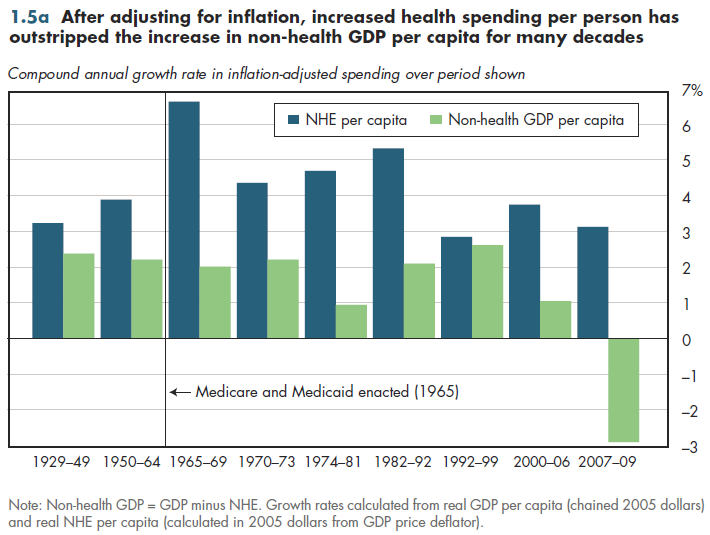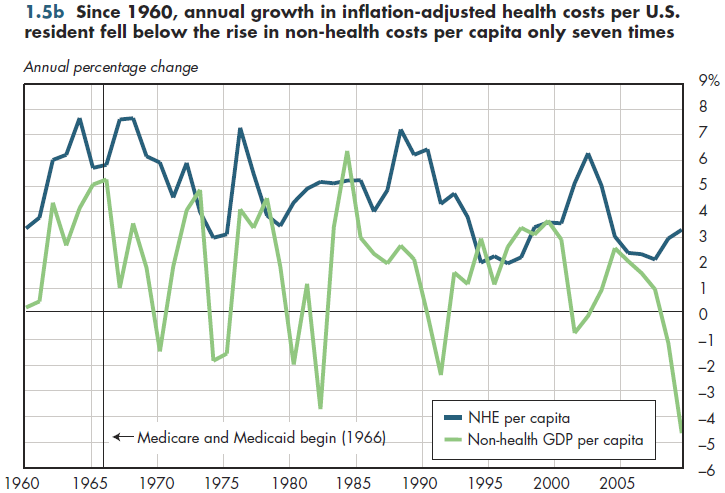For 80 years, per capita health spending has grown persistently each year from one to six percentage points faster than the non-health portion of the economy. Since 1929, annual growth in per capita NHE (4.1 percent) was slightly more than double the rate experienced in the rest of the economy.
However, the size of the disparity has changed dramatically over this period (figure 1.5a). Health spending growth has outpaced general economic growth by the largest margins during periods of significant expansions of public health insurance coverage (the introduction of Medicare and Medicaid in the 1960s, Medicaid expansion in the 1980s), and years marked by poor economic performance (for example, stagflation during the 1970s).

The more fine-grained data shown (figure 1.5b) are for a shorter time but demonstrate how infrequently annual growth in per capita non-health sector GDP has outpaced the rate of increase in NHE per capita since 1960. Rather than exhibiting a common pattern, the few cases in which this has occurred have unique explanations.

It is worth emphasizing from the previous discussion what these trends do (and do not) imply. Both sets of growth rates have been calculated from "real" (inflation- adjusted) per capita estimates of NHE and non-health sector GDP (that is, GDP minus NHE), using the GDP deflator to remove the effects of general economy-wide inflation. (Using chained dollars is a more precise way of measuring inflation than using the standard CPI.) Including the effects of health-specific inflation, the higher observed growth in real per capita NHE does not imply that growth in per capita health output has been double that of the rest of the economy. As well, components of both NHE and GDP reflect investments in capital or research and development (R&D) that might not pay off until future years. Thus, the growth rate differential is not a precise comparison of how Americans have consumed health care relative to everything else.
Our apparent willingness to increase expenditures on health care even during periods that the real economy is shrinking is suggestive of the relative priority of health care over everything else. Conversely, to date Americans have been able to enjoy a rising standard of living notwithstanding their high level of spending on health.
Download Excel tables used to create both figures:
Figures 1.5a/1.5b Tables.
Figures 1.5a and 1.5b both were created from the following table (the workbook includes all supporting tables used
to create this table):
- Fig. 1.5a: Table 1.5. Compound Annual Growth in U.S. Per Capita Real National Health Expenditures, GDP and Non-health GDP (chained 2005 dollars): 1929 to 2021
- Fig. 1.5b: Table 1.5.1 Compound Annual Growth in U.S. Per Capita Real National Health Expenditures, GDP and Non-health GDP (chained 2009 dollars): 1929 to 2021
Download PowerPoint versions of both figures.
- Centers for Medicare and Medicaid Services (CMS). National Health Expenditures Accounts: Methodology Paper, 2011. Definitions, Sources, and Methods. 2011a. Available at: http://www.cms.gov/Research-Statistics-Data-and-Systems/Statistics-Trends-and-Reports/NationalHealthExpendData/Downloads/dsm-11.pdf (accessed January 10, 2013).
- Centers for Medicare and Medicaid Services (CMS). Quick Definitions for National Health Expenditure Accounts (NHEA) Categories. 2011b. Available at: http://www.cms.gov/Research-Statistics-Data-and-Systems/Statistics-Trends-and-Reports/NationalHealthExpendData/Downloads/quickref.pdf (accessed January 10, 2013).
- Centers for Medicare and Medicaid Services (CMS), Office of the Actuary. National Health Expenditures by type of service and source of funds: CY 1960-2011. Last updated December 27, 2012. Available at: https://www.cms.gov/Research-Statistics-Data-and-Systems/Statistics-Trends-and-Reports/NationalHealthExpendData/Downloads/NHE2011.zip (accessed January 10, 2013).
- Cooper BS, NL Worthington and MF McGee. Compendium of National Health Expenditures Data. DHEW Pub No (SSA) 73-11903. Office of Research and Statistics. 1973.
- Hartman MB, RJ Kornfeld, and AC Catlin. A Reconciliation of Health Care Expenditures in the
National Health Expenditures Accounts and in Gross Domestic Product . Survey of Current Business, September 2010: 42-52. Available at: http://www.bea.gov/scb/pdf/2010/09%20September/0910_healthcare.pdf (accessed March 21, 2013).











